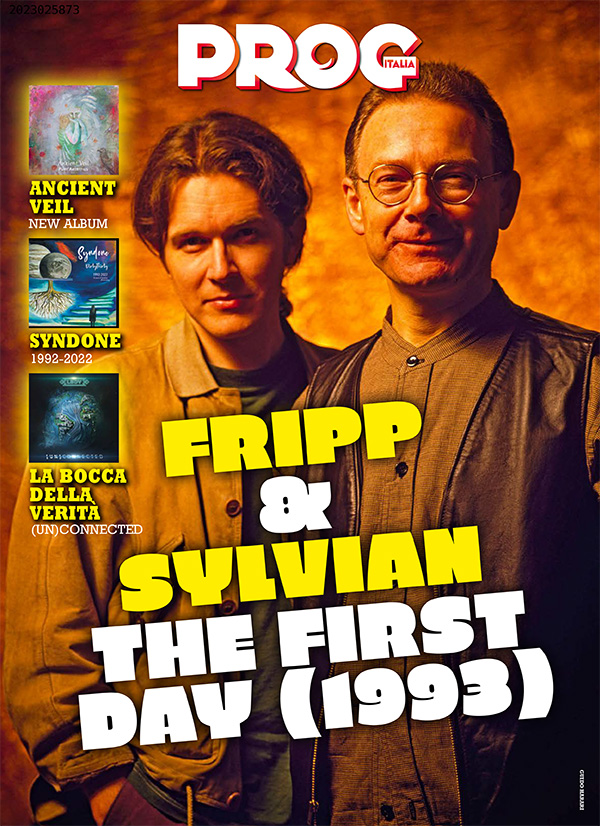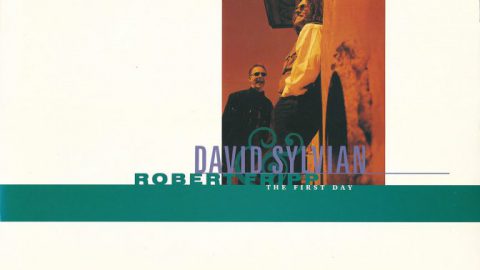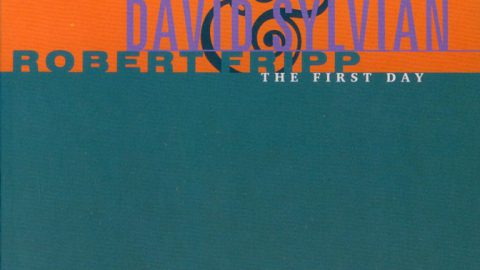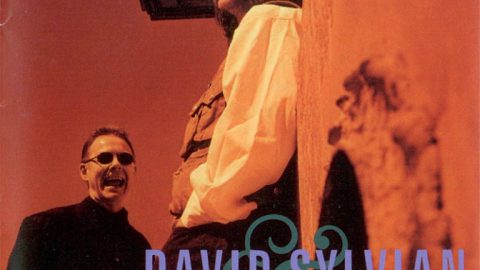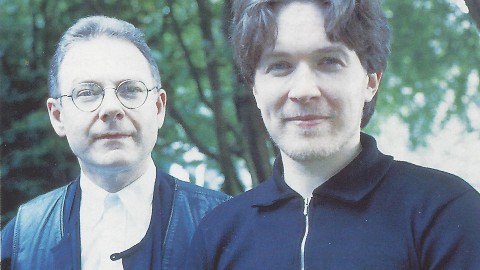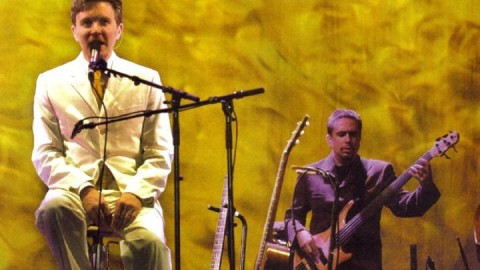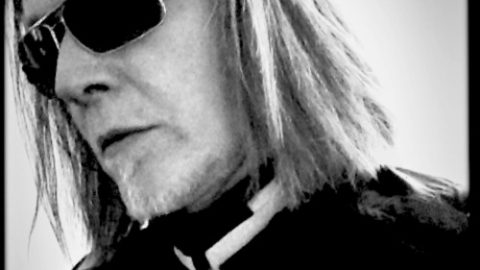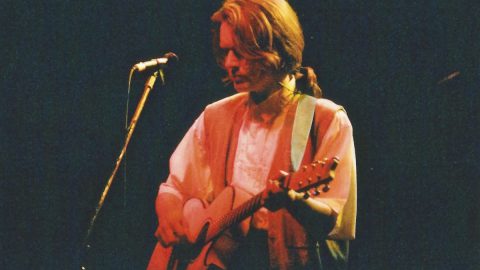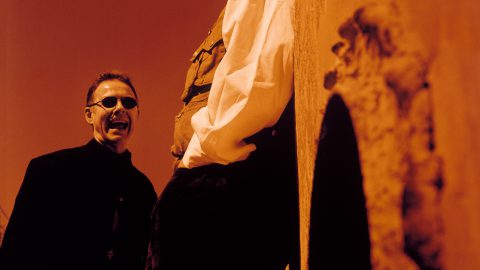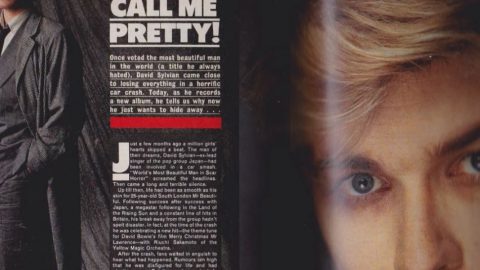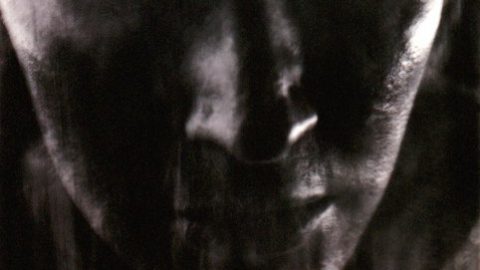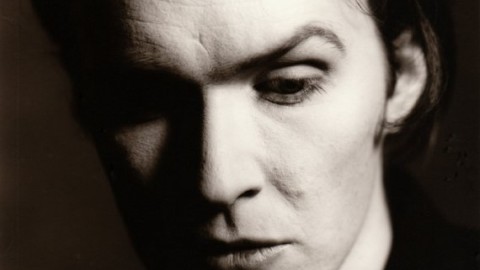The magazine includes an article by Marco Olivotto about the collaboration of Robert Fripp and David Sylvian in 1992/1993.
Translations kindly provided by Marta Roia
PROG ITALIA N. 51 – pages 58-65
THE ODD COUPLE?
Some artists unforgettably mark their era and they end up representing it, even though their fame is not equivalent to the importance of their work, like Robert Fripp and David Sylvian in THE FIRST DAY (1993)
Text: Marco Olivotto
“With its alternation between shadow
and light, THE FIRST DAY remains one of the most
significant moments of the nineties”
In English language you use seminal as an adjective to underline the originality of an artist and their ability to influence what will come. Robert Fripp and David Sylvian can rightfully earn that honour, even if they come from very different paths. They share eclecticism, which makes difficult the task to assign a precise genre to their music. After a collaboration in 1986, their winding paths cross in the early nineties, producing undisputed results.
It doesn’t seem necessary to retrace in detail their careers, probably already known by the readers of this magazine. It’s sufficient to mention that Fripp is a worldwide recognised key figure in progressive scene thanks to King Crimson, a changing and troubled ensemble, with whom the guitarist from Wimborne Minster created universally acclaimed masterpieces. Sylvian stands out with his Japan when progressive starts to decline, proving to be one of the most interesting artists in Britain during the late seventies. His background is glam rock and new wave, the latter a term which originally was an equivalent to punk, but that would soon become a general definition for kinds of music pretty distant from the mainstream genre, even though tending sometimes towards pop. Eight are the years that officially separate them, but less than a decade is enough to divide musical worlds that do not seem to have much in common. However, when their own sonic universes draw near, they create an entirely new sound which still fascinates for its complexity and its modernity.
In this article we retrace the history of THE FIRST DAY (1993) album, thirty years after its release. It’s the first official evidence of Fripp and Sylvian partnership, which will end a year later. The collaboration between the two artists started with GONE TO EARTH (1986), the second Sylvian solo record after his debut with BRILLIANT TREES (1984), created two years after Japan disbanding. In GONE TO EARTH, three pieces bear Fripp’s signature along with the singer, including the title track. His unique guitar holds the stage in several moments, also thanks to his popular fripperstronics. It’s the record that paves the way to SECRETS OF THE BEEHIVE (1987), considered Sylvian’s solo career masterpiece, to which, however, Fripp didn’t participate. Following works are characterized by the collaboration with Holger Czukay, German bassist and producer, founder member of Can. The avant-garde turn of these records isn’t a surprise, considering Czukay’s method and his direct artistic descent from Karlheinz Stockhausen.
In 1991, Fripp invited Sylvian to join him in a new KC ensemble for a short tour in Japan. It’s the kind of request any musician longs to receive, but the singer’s reply was negative: “Though very flattered, I decided that I didn’t feel equipped to take on the whole baggage and history that comes with being a member of King Crimson. So instead we took the offer of the tour as an opportunity to write material for an album” (from dgmlive.com).
The beginning of the artistic partnership that created THE FIRST DAY is usually dated back to 1993, but it’s not correct. This is witnessed by THE DAY BEFORE bootleg published in 1993 as well, but recorded in 1992 during an European tour which touched Italy too. A mainly improvised tour, whose repertoire was made of new rough tracks. It’s an interesting record because it contains almost all the pieces of the debut album, plus some others not included in the official work. Drums are completely absent: tour ensemble was composed, in additon to Fripp and Sylvian, by Trey Gunn on stick and by California Gruitar Trio members, consisting of Fripp’s guitar course students. The tracklist contains, besides the unpublished works, tracks as Urban Landscape (from EXPOSURE, 1979) and Ghosts (from TIN DRUM by Japan, 1981).
Probably the duo wasn’t excited by the release, also because rarely an artist loves bootlegs, even more so if they are published close to an official release. In retrospect, THE FIRST DAY unveils that the tracks, recorded during the tour a year before, were still in the process of writing: arrangements are different, and the strong rhythmic vein that characterizes the whole album is definitely missing. A vein not quite unfamiliar to Sylvian: Pulling Punches, the track that opens his first solo album, could very well be taken out of THE FIRST DAY, and at some points of the album itself it’s difficult to believe that Fripp didn’t take part in recording that 1984 work produced by Sylvian together with Steve Nye. At the same time, the pieces that surface during the first duo exhibitions mark a clear parting of the singer from his recent past. FLUX & MUTABILITY (1989, with Czukay) and RAIN TREE CROW (1991, with former Japan members) are albums where improvisation plays an important role, but they are pristine records, driven by the search of an intimate sound. The sound the duo creates on stage in 1992 is quite the opposite, with the fundamental support of Gunn. The material is harsh and characterized by electric sounds that very often become piercing. The former Japan member explains that the pieces were created rather quickly. “We started writing two weeks before the tour. Performance was inevitably marked by a state of flux” (from sylvianvista.com).
An interview to Paul Tingen and published in 1994 reveals some album background. The singer, called in the feature “thinking musician’s thinking musicians”, tells that the years before 1991 had indeed been “very dark and very heavy” for him and that it took him a long time to come through. “After 1988, I had been through hell for four years. I can only describe that period as a mental and spiritual crises . It was a negative period and I accepted to collaborate with Fripp as an instrument to go through it. Starting working on THE FIRST DAY made me feel that I was getting out of that period and that I could write about it and face it” (from “Sound On Sound”).
Some of the events in Sylvian’s private life show that 1992 is a turning point for him. Among these, there’s his meeting and subsequent marriage with Ingrid Chavez – singer-songwriter, poetess and visual artist coming from Prince entourage – who led him to move to Minneapolis.
Also the apparently detached Robert was yet attentive to his colleague’s mood and difficulties. “It happened at a time when I guess I would have condemned myself to silence, in any case. I didn’t have any desire to work at that time, and Robert was urging me to do something together. It was an interesting journey, in itself, and we worked together for a long time before closing the experience. At that time I could eventually go back to my solo career” (from dgmlive.com).
Sound conveyed the method used by the musicians involved in the recording. The team comes from the same world Fripp was tied to: behind drums sits Jerry Marotta, a long time Peter Gabriel’s collaborator; at the mixing table, David Bottrill, tied in turn to Gabriel. Bottrill, through Daniel Lanois, participated in albums such as SO (1986), PASSION (1989) and US (1992). Marotta didn’t stayed long in the team as he had been excluded from the project due to artistic disagreements. Many of the drumming parts you hear have originated from fragments of his own performances, then reworked by Bottrill. The soundscape that opens up has nothing in common with Sylvian’s latest work, produced by Nye and characterized by a well-smoothed sound. “I had a desire to go into another sonic area. I love the warmth and beauty of the tones Steve gets, and he also used to give me a lot of feedback on the way I arranged things. But as I have continued to develop, it just seemed natural to move away. We’d exhausted our relationship to some degree (from dgmlive.com).
Lyrics reflect the darkness of the previous period, but they are also crossed by moments of spiritual enlightenment. In the opening track, God’s Monkey, Sylvian doesn’t hide: “No songs to sing / That I believe in. / Can’t breathe the air / It’s too thin / This far from heaven”. “The problem at that time was that despite my belief I had a hard time experiencing the divine love I believe in, and could only approach it intellectually through the recollection of past experience. I attempted to express the anger, rage and impotence I felt at that time. The blindness, the absolute darkness” (from sylvianvista.com). God’s Monkey is Hanuman, the Hindu monkey-god guide that helps human soul to reach the divine. Sylvian’s invitation, maybe to himself, is “Climb the ladder / To God’s Monkey”.
Darshan as well starts from similar concepts. The term refers to the divine sight, e.g. the practice to look at or to perceive the presence of a deity or of a saint inside a temple. It refers to the moment you see and, at the same time, you are seen by the divine: a worship that opens the possibility of achieving spiritual advancement. Sylvian’s closeness to spiritual themes, especially Hinduism, crosses the whole album, which strikes you for the alternation of strong images, sometimes psychotic, and great hope openings towards light, one of the work’s recurring themes.
“I didn’t have any desire to work at that time,
and Robert was urging me to do something together”
David Sylvian
“Making the album was definitely a cathartic experience, both for Robert and myself. It comes out of traumatic experiences, but it also resolves them. In the end, healing takes place. It was a turning point for both of us” (from dgmlive.com). The improvisation at the base of the work gives it a clear authenticity. Darshan is an excellent example of the balance between performing freedom and arrangement. “There’s no guarantee that what feels good whilst you improvise is always going to be interesting for other people to listen to […]. Neither of us had thought of putting on a piece like Darshan, which is almost eighteen minutes of rhythmically repetitive music, with jazz-type improvisations going on throughout. So there was a lot of re-structuring going on in that piece, whilst at the same time I tried not to weaken the live performance that gave it its power in the first place. It was a way of combining Robert’s and my approach to recording music, and a challenge I enjoyed”.
Two different approaches, respectively distinguished by reasoning and instinct. Fripp is known for liking to work very quickly, avoiding endless repetitions of one take. It’s a typical approach that old school rock musicians have, which avoids the risk of hyper-produced and confused albums. Thanks to that, guitarist’s artistic performance is stratospheric, and it’s one of the peaks of his career. An unforgettable solo as the one in Firepower has been recorded in just one take, without any cut: a moment that David remembers as “extraordinary” (from sylvianvista.com).
The record was followed by a tour with several dates in Italy. I saw the duo performing at Teatro Smeraldo in Milan (November 15h 1993) with two exceptional friends: Paolo Benvegnù and Michela Manfroi, from the band called Scisma, with whom I was collaborating at the time. I remember it as a perfect concert, even though characterised by a certain air of detachment which well befitted the two leading figures. The show featured also tracks where Sylvian’s ambient flair reaches its peak, as opposed to the definitely much rhythmic atmospheres of the album. Among these, Damage, one of the pinnacles in his entire body of work. But on average it was a muscular gig, where all the sound power of THE FIRST DAY unfolded: catharsis in music, as Sylvian later confirmed. An excellent proof of that tour is in the live album called DAMAGE, released in 1994.
A comment on the live album is a must, even though it doesn’t relate to the topic we are dealing with. I bought it as soon as it came out because it contained that title track. At the concert I was so deeply touched by the ballad Sylvian played, with a very discreet accompaniment by the other band members (without drums, which at the time were played by Pat Mastellotto), to the point that I considered its presence inside the album reason enough to buy it. I was not the only one, it seems.
“Until the present incarnation of King Crimson, working with David was the happiest undertaking of my professional life; and this song, one of my all-time favouritists. What gorgeous singing, heart-wrenching! A privilege to accompany” (Fripp, from sylvianvista.com). “To sit silently crying, trembling motionless, on stage in a pool of light, night after night, during this song, was one of the hardest privileges of my life” (Pat Mastellotto, 2018, from sylvianvista.com).
What makes THE FIRST DAY fascinating is its sound diversity, a kaleidoscope which, however, doesn’t affect its coherence. The opening with GOD’S MONKEY, of decidedly funky matrix, is where Trey Gunn becomes the weaver of a persistent and pulsating stick line, close to Tony Levin‘s style, the most renowned standard bearer of that bizarre instrument that lies halfway between guitar and bass. Rhythm is determined and repetitive, and it becomes the perfect base for Fripp’s guitar take-offs. Many guitar parts intersect each other, creating a fascinating and complex net of harmonies and dissonances which closely recall certain King Crimson sounds.
JEAN THE BIRDMAN is the track that more comes close to a canonical song. Not by chance, it was released as a single in a curious format: a box consisting of two cds, which each one starts with the song followed by other four tracks, both unreleased and well-known. In the lyrics, quite cryptic, you find the story of a killer who murders six persons and he’s indifferent to the fact that “heaven may stone him”.
Completely different is the style of FIREPOWER, which is a track longer than ten minutes and opens up with a sound that partly recalls Vernons Reid’s(Living Colour) style. It is somewhat far-fetched to mention metal as an influence on Fripp in that period, but, without a doubt, some of his never interrupted sound researches take the cue from sounds close to that genre. The lyrics are among the darkest of the entire album, and they describe a deep psychic distress. The initial sound attack fades into a long instrumental section based on an obstinate and repetitive rhythm, on which Fripp weaves his magic, interchanging distorted guitar paintbrushes with his dream-like Frippertronics’ sounds.
BRIGTHNESS FALLS takes possession of many American alternative rock groups’ style of the time, reworking it: crooked chords and bold armonies, created by Robert, that unfold on a rhythmic base which at times recalls hip-hop. The contamination of the most diverse genres results however in a cohesive and sensible sound form, where Fripp – if there ever was any need to – proves to have stellar talents, which combine an impressive performing polish with a meticulous choice of the most suitable sounds to achieve desired musical outcome. The song deals with the theme of relinquishment and solitude as night approaches.
20TH CENTURY DREAMING (A SHAMAN’S SONG) is a song with a heavy sound, which eyes once again certain metal declensions. Lyrics start with a social criticism towards a world that demolished “faith in justice, hope and happiness”, but it’s also a sort of self-incitement to “moving to the house of love”. As in Firepower, strength fades in the second part of the track, making way for an hypnotic stick riff, supported by jazz-style drums, which seeks sound subtlety more than power. On this music pedal, a particularly intense Sylvian emerges, and for a while he goes back to the intimism of his most recent works, suggesting that the game “could be different this time / You may win”.
“Working with David was the happiest undertaking
of my professional life outside King Crimson”
Robert Fripp
DARSHAN is one of the work’s cornerstones. It’s intriguing to make the connection, perhaps just an ideal and not sought one, between the sounds of this record and those of other almost ignored tiny jewels of the time, as the innovative NERVE NET (1992) by Brian Eno. It’s not by chance that hyperactive Fripp had found himself interacting several times with musicians belonging to the seminal category mentioned at the beginning, frequently ending in going in the same direction, or, at least, moving with similar intentions.
THE FIRST DAY ends on a note of light, with BRINGING DOWN THE LIGHT. Performed by Fripp alone, the track is introduced by one of the most beautiful Frippertronics’ soundscape the guitarist has ever created. It’s no coincidence that it’s an instrumental piece: Sylvian’s harsh and disturbing words disappear, making way for a sound mist that conjures the rediscovered serenity.
With its alternation between shadow and light, THE FIRST DAY remains one of the most significant moments of the nineties. The indefinable genre, the outstanding performing level, the sound grandeur that the record is able to conjure are the proof of the efforts made by two different but similar souls, who, in their musical union, have created a record that far exceeds the sum of individual parts, and where suffering is sublimed, producing pure Beauty.
